 English
English


zero sequence impedance test of transformer
Zero Sequence Impedance Test of Transformers
The zero sequence impedance test of transformers is a critical diagnostic procedure that plays a vital role in evaluating the performance and condition of transformer insulation and the coupling between windings. In electrical engineering, understanding and assessing the behavior of transformers under different operating conditions is essential for ensuring reliability and efficiency in power systems. This article delves into the importance of the zero sequence impedance test, its methodology, and its implications for transformer maintenance.
Understanding Zero Sequence Impedance
Zero sequence current refers to the condition when the three-phase currents of a system are equal. In a healthy system, this condition ideally should not exist. However, in real-world scenarios, conditions such as ground faults can cause such currents to flow. The zero sequence impedance is essentially a measure of how a transformer responds to these equal current conditions. It is crucial as it reflects the transformer's behavior during fault conditions, particularly during ground faults, and helps in assessing the grounding system's effectiveness.
Importance of the Zero Sequence Impedance Test
1. Fault Analysis The zero sequence impedance test helps in understanding how a transformer would behave during single-phase faults and ground faults. Knowing this impedance is vital for predicting fault currents and designing protection systems accordingly.
2. Insulation Assessment This test provides insights into the insulation integrity of the transformer windings. High zero sequence impedance may indicate insulation degradation or issues within the winding structure.
3. Transformer Protection It assists engineers in calibrating relay settings for protective devices. Accurate zero sequence impedance values contribute to more effective fault detection and relay operation.
4. Design Validation Understanding the zero sequence impedance can also be significant during the design phase of transformers, ensuring that the transformer meets the specific requirements of the application it is intended for.
Methodology of the Test
The zero sequence impedance test is typically performed using specific configurations designed to apply equal current to all three phases of the transformer. The following general steps outline the testing methodology
1. Preparation Before conducting the test, ensure that the transformer is de-energized and properly isolated for safety. Check all connections and measurement devices.
zero sequence impedance test of transformer

2. Phase Connection The transformer windings should be connected in a manner that allows the application of zero sequence currents. This typically entails connecting all three phases together.
3. Current Injection A current source is used to inject a predetermined current into the transformer. This current should ideally be equal in magnitude and phase for all three phases.
4. Measurement During the injection of zero sequence current, voltage measurements are taken across the transformer terminals. The impedance can be calculated using Ohm’s law (Z = V/I), where V is the voltage across the terminals, and I is the injected current.
5. Analysis The measured impedance can then be analyzed and compared with established benchmarks or previous test results to assess the transformer's condition and performance.
Implications and Applications
The results obtained from the zero sequence impedance test can have several implications for the operational reliability of power systems
- Routine Maintenance Regular testing can help in identifying potential problems early, allowing for preventive maintenance actions before a failure occurs.
- System Coordination The data helps in the coordination of protective devices, ensuring that they operate correctly under fault conditions, thus enhancing the security and resilience of the power supply.
- Regulatory Compliance Many regulatory bodies mandate periodic testing of transformers. Conducting zero sequence impedance tests ensures compliance with such regulations, safeguarding against penalties and ensuring public safety.
- Operational Efficiency By understanding the transformer's zero sequence behavior, operators can optimize its performance for improved efficiency, reduced losses, and extended lifespan.
In conclusion, the zero sequence impedance test of transformers is an essential procedure in the realm of electrical engineering. It provides critical insights into the operational health of transformers, aiding in fault analysis, insulation assessment, and ultimately ensuring the reliability of power systems. As technology continues to evolve, the value of such diagnostic tests becomes even more pronounced, highlighting the need for engineers to incorporate them into routine maintenance strategies.
-
Differences between open cup flash point tester and closed cup flash point testerNewsOct.31,2024
-
The Reliable Load Tap ChangerNewsOct.23,2024
-
The Essential Guide to Hipot TestersNewsOct.23,2024
-
The Digital Insulation TesterNewsOct.23,2024
-
The Best Earth Loop Impedance Tester for SaleNewsOct.23,2024
-
Tan Delta Tester--The Essential Tool for Electrical Insulation TestingNewsOct.23,2024





